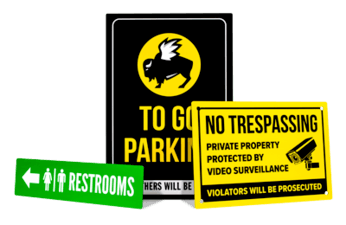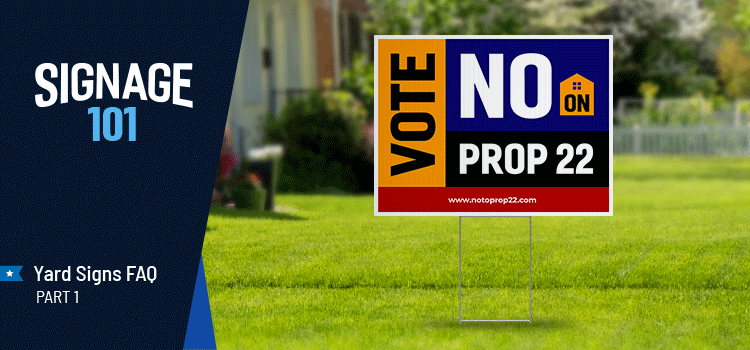Yard signs are among the most popular displays used all over the world. It’s a tried and tested classic that works for simple garage sales, budding realtors, to political candidates. It’s a versatile promotional tool that can be used by anyone from any industry. While the humble yard sign may seem simple and straightforward, there’s more to it than meets the eye. In this article, we explore some of the most common questions our customers ask us about yard signs.
How To Put Up or Install Yard Signs
The simplest and most popular way to install yard signs is by using wire stakes. These are H-shaped steel stakes that you drive into the ground. They are lightweight, easy to transport, and when used correctly, reusable. Putting them up is simple:
- Find a suitable surface where your yard sign will be displayed. Ensure the surface is soft enough to insert the wire stake but firm enough to hold your sign up.
- To install the wire stake, push it far enough in that it will support the yard sign. You can use your foot to add extra force if the ground is firmer. Take care when doing either that you don’t bend the wire stakes as you do so.
- Once the stake is firmly placed in the ground, you can slide on your yard sign. Align the corrugated flutes inside of the yard sign with the top prongs of the stake and slide it on.
Our wire stakes come in standard and heavy-duty versions. Standard is made from 9-gauge steel while heavy-duty has a sturdier base made from 1/4″ steel with a welded top also made from 9-gauge steel. The heavy-duty stake provides more stability and strength when facing windy conditions. With routine care and maintenance, wire stakes can be reused for years.
While wire stakes are the most common way to put up yard signs, they are versatile enough to work with other display methods as well. Signs.com offers three different metal frames and suction cups that can all be used to display yard signs.
Additionally, wooden stakes are yet another way to display yard signs. The primary advantage of these is that they are easier to drive into hard surfaces than the traditional wire stakes. You can then attach your sign to the wooden stakes via a screw or bolt with a head that is big enough to hold the sign in place – but be careful not to splinter the wooden stake in the process. This is typically a more laborious and costly method of displaying them but can work better if they are going to be up for an extended period.
Spider stakes are a modern take on the traditional H-stakes. They are easy to install, give additional wind resistance, and are made of 100% recycled material.
If your yard sign has grommets, you can also hang them using rope, hooks, or zip ties.
If your location is prone to strong wind, we recommend installing the yard signs at a slight angle so that the sign itself doesn’t absorb the full impact of the wind. You should also try to drive the wire stake as deep as you can, within reason, to strengthen the base support. Another tip to combat strong winds is to use two stakes. On smaller signs, you can install the first stake normally, then use one prong from a second stake and insert it in the middle of the yard sign panel, creating a T-shape. Drive both stakes into the ground. For larger signs, that do not result in horizontal fluting, Signs.com offers two wire stakes that can both be installed in standard fashion to help keep your signs upright and displayed as they are intended.
If you plan to put up really large yard signs and that need to be displayed for an extended period of time it is common to reinforce the back before displaying them. Otherwise, you run the risk of the signs toppling over or being damaged by the wind. Similar to the wooden stakes method above, you can attach the sign to a large piece of plywood that will serve as a protective and sturdy backing. With or without the solid backing, a custom wooden or metal frame will also help your oversized yard sign last for the long run while displayed outside.
Rules and Regulations of Displaying Yard Signs
While the process of designing, buying, and displaying yard signs is super easy, there are a number of common questions as it relates to displaying your yard signs. The most common is: where can one put yard signs? Additionally, how long can they be displayed for? What about what they can and can’t say? Does this differ where the yard sign is placed – on private property vs. public property? All of these questions are worth thinking about as you move through the design and ordering process. While we’re not legal experts, as best as we can, we’ve tried to address some of these questions around yard sign placement below.
Where Can I Put Yard Signs?
Some states, municipalities, and homeowners’ associations (HOA) have strict rules regarding the use of yard signs, whether it’s political in nature or not. In general, as long as the yard signs are placed within your property, you have the freedom to do so. This means that you can place for sale signs, advocacy messages, religious messages, or political support on your lawn or property without fear of running into any issues. Which, of course, as it relates to freedom of speech makes perfect sense. However, placing yard signs outside your property, such as in empty lots, along city streets, public parks, etc., depends on local rules and regulations and as noted below this public display of certain messages is where personal rights such as freedom of speech and local laws have collided in recent years. Thus, simply put: for yard sign use outside your personal property, it’s best to consult with the municipality, homeowner’s association, or other applicable governing body to make sure you are adhering to any rules or regulations that may be in place as it relates to where your signage can be displayed.
How Long Can My Signs Stay Up?
Once again, this answer is contingent on where your yard signs are displayed. Of course, on private property, we know of no rules or regulations that state that lawn signs can only be displayed for a certain period of time. Of course, if your private property is governed by some kind of HOA and you’ve agreed to certain covenants and restrictions there might be some duration limitations but otherwise, you are free to display the sign(s) for as long as you wish.
On public property, once again, it is prudent to verify if there are any stipulations surrounding the duration of displaying signage. We know for certain that many cities often give political candidates “x” number of hours or days after the election has ended to remove all signage from public property. Understandably the administrators of certain public property locations don’t want signage from past elections, causes, and events permanently displayed in an unsightly and dated way. So, whether you’re a political candidate, a supporter, or have placed yard signs for an entirely different reason on public property, make sure to know what is required as it relates to the removal of your sign.
What Can I Put On My Yard Signs?
The actual content of your yard sign is far and away the most complicated part of the public display of yard signs. Like the questions around where and for how long, there is both a public and private property angle to consider as it relates to the actual content of your sign.
We would assume that on private property you can display religious or political (or otherwise) related yard signs with whatever you want on them given that it is your private property and it would fall under freedom of speech rights. That said, you may want to make sure that there are no HOA regulations surrounding the content of your displayed signage.
That said, and regardless of possible HOA regulations, there may be some cases where what you put on your sign is regulated. For example, can you display signs about your immediate neighbor or others in your neighborhood? Generally speaking, yes, as long as it’s within your property it is your constitutional right. However, you may only be permitted to do so if you’re abiding by local laws and regulations, as well as your HOA agreement. For example, in some cases, you can’t display yard signs calling your neighbor a sexual predator. In some places like Starke, Florida, and Corpus Christi, Texas, it is the police and local government who are authorized to display such signs. While there is no way for us to detail every single city or municipality’s governing laws as it relates to this one example, let alone all of the unique situations that may arise, if you plan on putting up signs with potentially offensive content to some, it’s best to take a moment and consult any governing bodies and local laws before doing so even if the message is factually correct.
On a similar note, even when you’re displaying signage on private property, creating and displaying signs that display unsubstantiated claims or misinformation may be deemed as harassment, defamation, or run afoul of fair business practices. Any of these scenarios could quickly become an invitation to a lawsuit or create other legal issues. So, while you might have the freedom to display anything you want, we’d urge caution, common sense, and decency as you determine what your sign on your private property will display.
As for what you can and can’t put on your yard signs when displayed on public property it can be even more complicated. In the landmark case, Reed v. Town of Gilbert, Ariz., 576 U.S. 155 (2015), the United States Supreme Court deemed that sign placement regulation on the basis of content is unconstitutional. Thus, while it may appear that this gives the sign creator carte blanche as to messaging undoubtedly the governing bodies of said public properties have their own set of rules and restrictions in an effort to avoid situations that may create contention and/or liable situations. While we once again can’t detail all the scenarios or write a brief that balances freedom of speech rights vs. public display of signage messaging we’d recommend ensuring that your signs’ message will be in compliance with any possible regulation or laws that might be in place where you plan on displaying them.
While the above questions around location, duration, and content of yard signs can very quickly veer into complicated legal areas, for the vast majority of sign uses you can rest assured that with a little common sense and decency you’re probably just fine in displaying your yard signs with the original messaging. To be safe, and because we’re not legal experts, we’d still highly recommend verifying with any governing body or location where you might be displaying your yard signs to make sure the location, duration, and content of your yard sign display won’t cause any issues.
How To Protect Yard Signs?
The simplicity of yard signs also has a negative – they can be vandalized, stolen, or damaged. While this is illegal, it does happen sometimes, especially during election season when yard signs are seemingly everywhere and emotions run high. The best way to avoid this scenario is to make sure that your yard signs are placed in a well-lit, visible area inside your property to deter trespassers. If you have a CCTV camera, make sure that your yard signs are within view as well to catch the faces of the culprits.
Though it isn’t currently offered by Signs.com, you can also use an anti-graffiti laminate to help protect your signs that may not be placed on your property or with any kind of video surveillance deterrent. This film is placed on top of your sign to protect it from stains, chemicals, permanent markers, and paint. If your sign does get vandalized, you can use household cleaners on the laminate to remove the marks without risking damage to your yard sign. While this is an additional cost to consider, it ensures that your signs are safe from being defaced by anyone with ill intent. Lastly, you can also opt to remove the yard signs at night and put them up again in the morning.
While corrugated plastic is weatherproof, inclement weather can still damage it. Extreme weather conditions, such as ones with abnormal amounts of precipitation, wind, or temperatures, can negatively affect your yard signs. If the weather forecast is bad, we recommend stowing them away until the weather passes. For very little effort, this will ensure the longevity of your yard signs.
Can Yard Signs Have Grommets?
While wire stakes are far and away the most common way to display yard signs, grommets are sometimes used as well. Grommets are small metal rings usually used with vinyl banners for easy hanging. These are located on the corners of the banner and you can use rope, zip ties, or suction cups to hang your banner. Likewise, you can select grommets to be placed on your yard sign so you can hang it up on your door, windows, or anywhere you prefer. Our yard signs are weatherproof, so you can hang them indoors or outdoors. When using them outdoors, make sure the grommets are tightly tied or firmly secured to ensure it doesn’t fall down.
The primary advantage of choosing grommets for your yard sign is the added display versatility that comes with it. You can display it using wire stakes or hang it with rope and hooks. This is a good option to consider if you’re always changing the location of your signs or need to display it in a unique way. It ensures that you can display your marketing materials whatever the place or situation. However, grommets do have the potential of interfering with your design. Thus, if you know you need grommets for your yard sign make sure to design your sign in a way that the grommets (in the four corners or top two corners) don’t detract from your design or main message in any way. While grommets for your yard sign are a far less common option there is no doubt they still look great and add even more versatility to an already great sign choice!
How To Store Yard Signs
After the seasonal events are over, you’ll need to store your yard signs properly to keep them in good condition. Since our corrugated plastic signs last for years, you can reuse them once the situation presents itself.
We recommend storing yard signs upright next to each other. You can store it flat and stacked but make sure not to place anything heavy on top of it to prevent permanent unsightly dents and creases (unlike vinyl banner wrinkles or creases these will not come out). This also goes for wire stakes. Placing heavy items on top of the stakes can make the steel bend, rendering it unusable.
Store the yard signs in a cool, dry place. Dirt and humidity can in some cases lead to mold formation. When the time comes to display your yard signs again simply wipe them down with a wet rag and they should be good to go!
That’s A Wrap!
We hope that our brief guide on some of the finer side of yard signs can assist you in making the right decision as you purchase yard signs. With this extra knowledge, we’re confident that you’ll get plenty of value from a true time-tested signage solution.




































